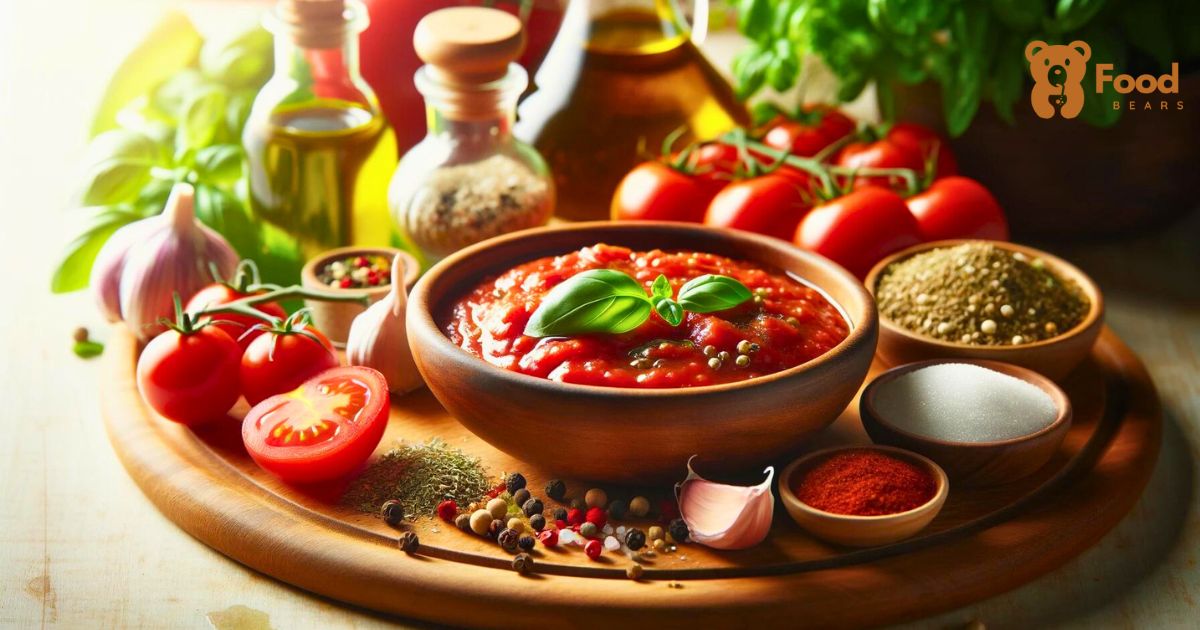The allure of a perfect pizza is undeniable, and it often starts with the sauce. This essential component, frequently overlooked, is every slice’s flavor’s heart.
Each ingredient in pizza sauce is not just a trivial addition. It carries weight, enhancing flavors and contributing to the overall culinary experience.
Understanding the role of each ingredient is vital to mastering pizza sauce. From tomatoes’ robustness to garlic’s subtle kick, every element plays a pivotal role.
But it’s not just about taste. These ingredients bring notable health benefits to the table, adding another layer of value to your homemade sauce.
This exploration will delve into the culinary fundamentals that make a pizza sauce outstanding. We’ll uncover the health benefits of common sauce ingredients, showing you why each deserves a spot in your kitchen.
The Essential Ingredients of Pizza Sauce
Creating an excellent pizza sauce requires a balance of flavors from a few key ingredients. Here are the essential components you’ll typically need:
1. Olive Oil: The Heart-Healthy Base of Flavorful Pizza Sauce
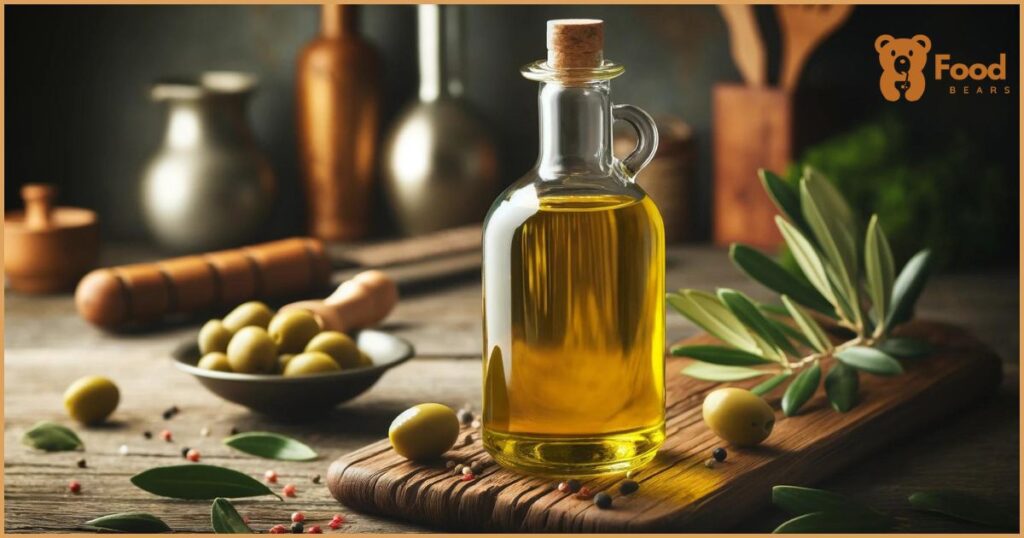
Olive oil isn’t just another ingredient; it’s the foundation that sets the stage for a rich and smooth pizza sauce.
When heated, olive oil acts as a perfect medium to carry. Intensify the flavors of garlic, onions, and herbs, blending them into a cohesive and delightful sauce.
Role in Sauce
- Enhances flavors: Olive oil captures and distributes the taste of each spice and herb evenly.
- Creates smooth texture: It helps emulsify the sauce, giving it a silky consistency that spreads flawlessly over homemade pizza dough.
Health Benefits
- Promotes heart health: Rich in monounsaturated fats, olive oil is known for reducing the risk of heart disease.
- Packed with antioxidants: These compounds help combat oxidative stress linked to numerous health conditions.
In every tablespoon of olive oil, you’re adding taste and wellness. This is why choosing a good quality extra-virgin olive oil can make a difference in the flavor profile of your pizza sauce and its health benefits.
You’re making a culinary choice by integrating olive oil into your pizza sauce. That enhances the dish’s flavor and contributes positively to your health.
2. Garlic: The Flavor Enhancer with Powerful Health Benefits
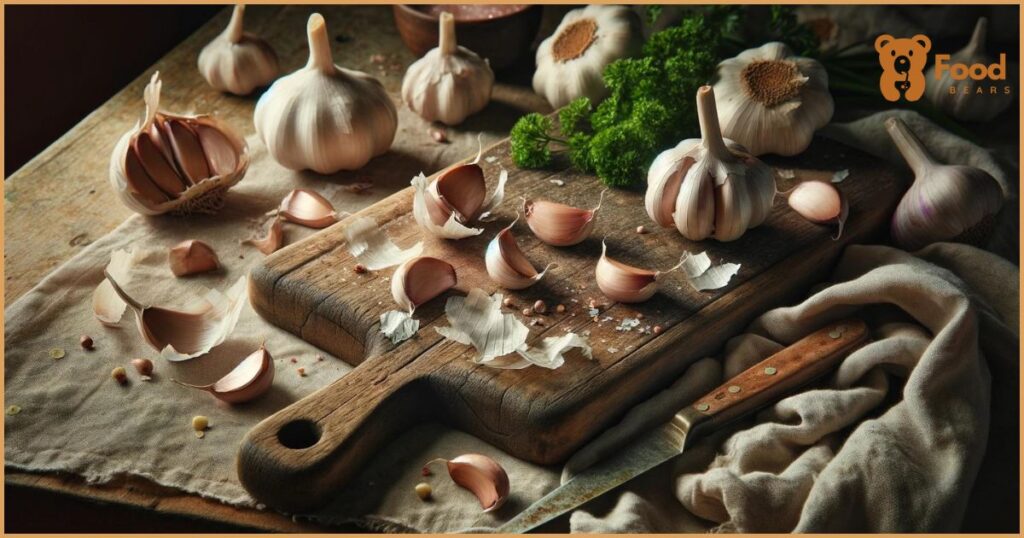
Garlic plays a pivotal role in the foundation of any great pizza sauce. Its robust flavor deepens the taste profile of the sauce and melds harmoniously with the other ingredients to create an aromatic and flavorful base.
Role in Sauce
- Builds a flavor foundation: Garlic adds a depth of flavor essential for pizza sauce’s rich, complex taste.
- Acts as a natural flavor enhancer: It releases its essential oils by sautéing garlic in olive oil, infusing the sauce with its distinctive aroma and taste.
Health Benefits
- Boosts the immune system: Garlic is renowned for its properties that enhance the immune system, helping to fend off common colds and other infections.
- Disease prevention: Regular consumption of garlic has been linked to a reduced risk of certain cancers and heart-related conditions, thanks to its high levels of allicin.
Garlic is not just about adding zest to your sauce; it’s about adding a layer of health protection. Including garlic in your pizza sauce ensures you’re not just treating your taste buds. But also supporting your body’s natural defenses.
3. Tomatoes: The Vibrant Heart of Pizza Sauce

Tomatoes, like crushed tomatoes and tomato paste, are indispensable in crafting an authentic pizza sauce. They provide the base, vibrant color, and rich flavor characteristic of a classic pizza sauce.
Role in Sauce
- The base of the sauce: Tomatoes form the backbone of the sauce, imparting a deep red color and a tangy sweetness that balances other flavors.
- Enhances overall flavor profile: The natural acidity of tomatoes complements the savory notes of garlic and herbs, creating a well-rounded taste.
Health Benefits
- Rich in lycopene: Tomatoes are a leading source of lycopene, an antioxidant linked to many health benefits, including reduced risk of heart disease and cancer.
- Loaded with vitamins and antioxidants: They are also a good source of vitamin C, potassium, folate, and vitamin K, all of which are important for overall health.
Tomatoes aren’t just for color and taste; they’re a powerhouse of nutrition. Incorporating them into your pizza sauce makes it delicious and significantly healthful.
This versatile fruit, yes fruit, not only elevates the culinary quality of your sauce but also enhances your diet with essential nutrients.
Using tomatoes in your pizza sauce is an easy way to enjoy their rich flavor while tapping into their impressive health benefits.
They’re truly the heart of any pizza sauce for their culinary attributes and nutritional value.
4. Seasonings: The Secret to Perfectly Balanced Flavors
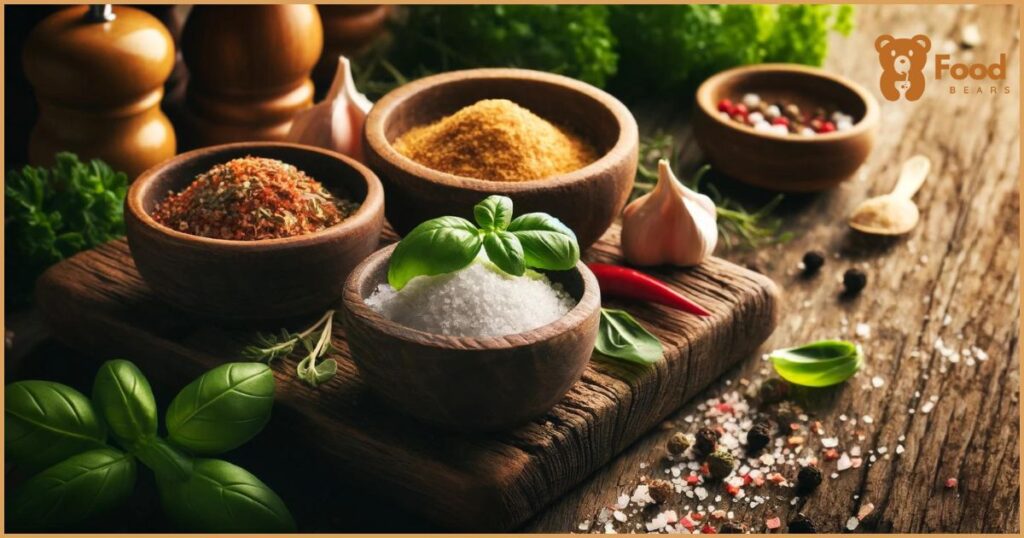
Seasonings like salt, pepper, onion powder, garlic salt, and Italian seasoning are essential in creating a pizza sauce that sings with flavor.
Each of these components works together to enhance and balance the natural tastes of the other ingredients. It is ensuring that every bite is as delicious as the last.
Role in Sauce
- Depth of flavor: Salt and garlic salt help to deepen the flavors, making them more pronounced.
- Balances seasoning: Italian seasoning, a blend of herbs including oregano, basil, and thyme. It adds complexity and a touch of warmth, while onion powder brings a subtle sweetness that rounds out the sauce.
Health Benefits
- Mineral content in salt: While salt should be used in moderation, it is also essential for body function.
- Antioxidant properties of herbs: Herbs in Italian seasoning add flavor and offer antioxidants that can support health.
Seasonings are the unsung heroes of pizza sauce. They might seem simple, but their impact on the sauce’s flavor profile is profound.
The right balance of these seasonings can transform a good pizza sauce into a great one, making each ingredient shine.
5. Herbs: Basil and Oregano—Bringing Italian Tradition to Your Sauce
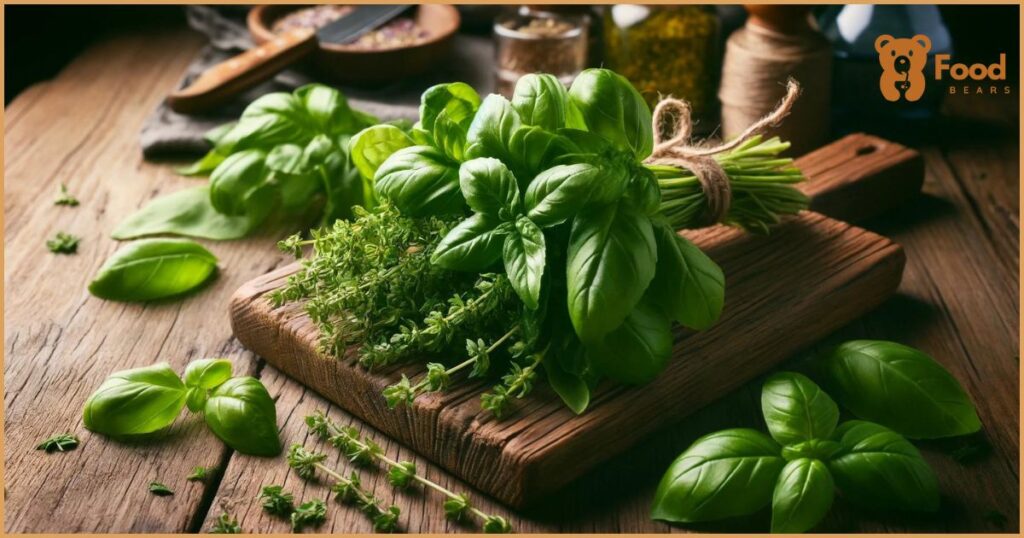
Basil and oregano are more than just herbs. They are the essence of Italian cuisine, imbuing your pizza sauce with the quintessential flavors. That defines this beloved culinary tradition.
Role in Sauce
- Aromatic touch: Basil offers a sweet, peppery flavor, while oregano provides a robust, earthy note. Together, they create a distinctly Italian aroma that is immediately recognizable and deeply comforting.
- Defines Italian roots: These herbs are staples in Italian cooking, bringing authenticity and traditional flavor to your sauce.
Health Benefits
- Anti-inflammatory properties: Both basil and oregano contain compounds like eugenol and thymol, which have been studied for their ability to reduce inflammation in the body.
- Promoting digestive health: Oregano, in particular, is known for its benefits to the digestive system, helping to soothe upset stomachs and support healthy digestion.
Basil and oregano do more than flavor your sauce. They infuse it with health benefits. These herbs enhance the taste of your pizza sauce and contribute to your well-being. You are making them indispensable in both culinary and medicinal terms.
6. Sugar: The Sweet Balancer in Pizza Sauce

Sugar, often seen as a simple sweetener, plays a critical role in the chemistry of pizza sauce. Its primary function is not to sweeten but to balance the natural acidity of tomatoes. They create a more harmonious flavor profile.
Role in Sauce
- Balancing acidity: The sweetness of sugar neutralizes the sharpness of tomatoes, enhancing the overall taste and reducing bitterness.
- Enhances flavor depth: By moderating the acidity, sugar allows the flavors of other ingredients, like herbs and spices, to shine through more vividly.
Health Benefits
- Moderation is key: While sugar is essential for balancing flavors, it benefits health only when used in moderation. Excessive consumption can lead to health issues, so using enough to achieve the desired flavor balance is important without overdoing it.
Sugar may seem like an optional add-on, but its impact on pizza sauce is significant. It softens the acidic bite of tomatoes, making the sauce more palatable and allowing the rich flavors of other ingredients to emerge.
This subtle yet crucial addition ensures that your pizza sauce has just the right touch of sweetness to complement its savory elements.
Understanding and controlling the sugar in your pizza sauce allows you to enjoy a perfectly balanced flavor that enhances your dishes without compromising health.
7. Crushed Red Pepper: The Spicy Enhancer for Pizza Sauce
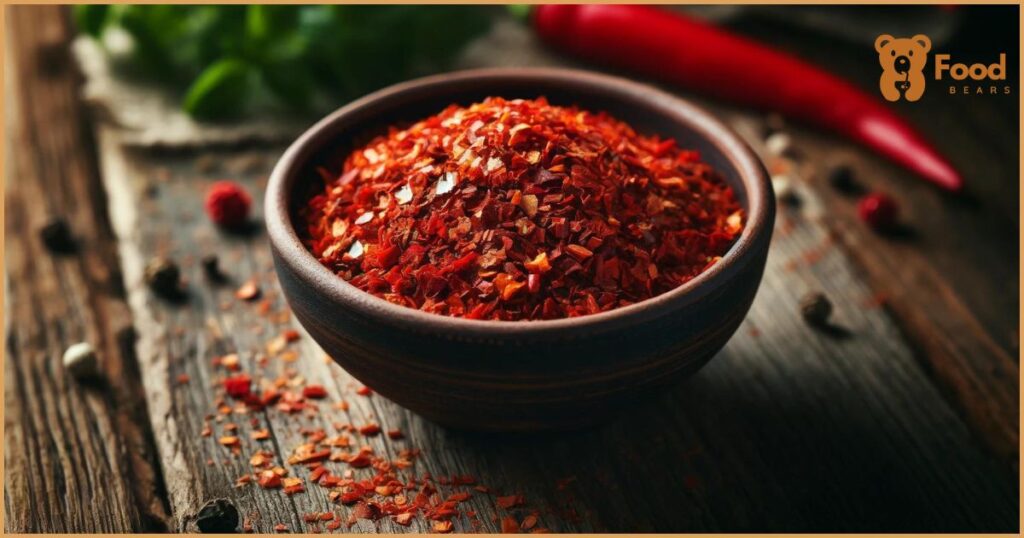
Crushed red pepper adds more than just a kick to your pizza sauce. It introduces a layer of complexity that can elevate the most straightforward recipes.
Incorporating this spice can transform a traditional pizza sauce into a more dynamic and exciting condiment for those who appreciate a bit of heat.
Role in Sauce
- Adding heat: Just a sprinkle of crushed red pepper can significantly change the flavor dynamics of your pizza sauce, introducing a spicy element that appeals to heat lovers.
- Enhances overall flavor profile: The heat from red pepper can enhance the natural flavors of other ingredients, making the sauce more robust and lively.
Health Benefits
- Metabolism-boosting: Capsaicin, the compound that gives red peppers their heat, is known for its ability to boost metabolism. This can lead to increased energy expenditure and potentially aid in weight management.
- Encourages healthy eating: The refreshing taste of spicy foods can make more nutritious meals appealing, promoting a more diverse and nutrient-rich diet.
Adding crushed red pepper to your pizza sauce isn’t just about spicing things up. It’s also about enhancing the overall eating experience and providing health benefits.
For those who enjoy a little heat, this optional ingredient can make your homemade sauce stand out, offering bold flavors and a metabolic boost.
Culinary Impact: Crafting the Perfect Blend
When crafting pizza sauce, the culinary synergy of the ingredients is crucial. Each component, from the rich base of tomatoes to the subtle kick of crushed red pepper, plays a pivotal role in creating a harmonious flavor profile.
Here’s how these elements come together to elevate your sauce:
Synergy of Ingredients
- Tomatoes provide the base, lending their vibrant color and tangy sweetness.
- Herbs like basil and oregano infuse the sauce with aromatic Italian flair.
- Seasonings adjust depth, balancing the sauce’s flavor complexity.
- Olive oil enriches consistency, ensuring smooth integration of flavors.
- Garlic and onion powders build a foundational savoriness that is unmistakably rich.
Each ingredient doesn’t just add its taste; they combine to create a greater whole. This synergy is what makes homemade pizza sauce recipes so unique.
Cooked vs. Raw Sauce
- Cooked Sauce: Heating the sauce allows for more prosperous, more mellow flavors. The heat breaks down the tomatoes and garlic, melding all the elements into a cohesive blend.
- Raw Sauce: Used primarily for fresher, zestier preparations, raw pizza sauce retains the bright, punchy flavors of tomatoes and herbs, offering a vibrant contrast to the melted cheese on pizza.
Flavor enhancement is more than just seasoning; it’s about how cooking transforms the ingredients.
Whether you simmer your sauce to deepen its flavors or mix it raw for a fresh, tangy kick. The preparation method plays a significant role in the sauce’s culinary impact.
| Aspect | Cooked Sauce | Raw Sauce |
|---|---|---|
| Flavor Profile | More prosperous, more integrated flavors due to simmering. | Brighter, sharper flavors, highlighting fresh ingredients. |
| Texture | Smooth and homogeneous, as ingredients meld together. | Chunkier and more distinct textures. |
| Preparation Time | Longer requires cooking. | Quick to prepare, no cooking needed. |
| Ingredient Potency | Cooking softens the potency of garlic and herbs. | Raw ingredients retain their potent flavors. |
| Acidity | Reduced acidity, as cooking mellows tomato sharpness. | Higher perceived acidity from fresh tomatoes. |
| Uses | It is ideal for traditional pizza, requiring baking. | Great for cold dishes or fresh-tasting pizzas. |
| Nutritional Value | Some nutrients, like vitamins, may be reduced during cooking. | Preserves most of the vitamins and enzymes. |
| Overall Taste Impact | It develops depth and complexity and is often preferred for depth. | Provides a zestier, more immediate taste impact. |
How to Make Pizza Sauce?
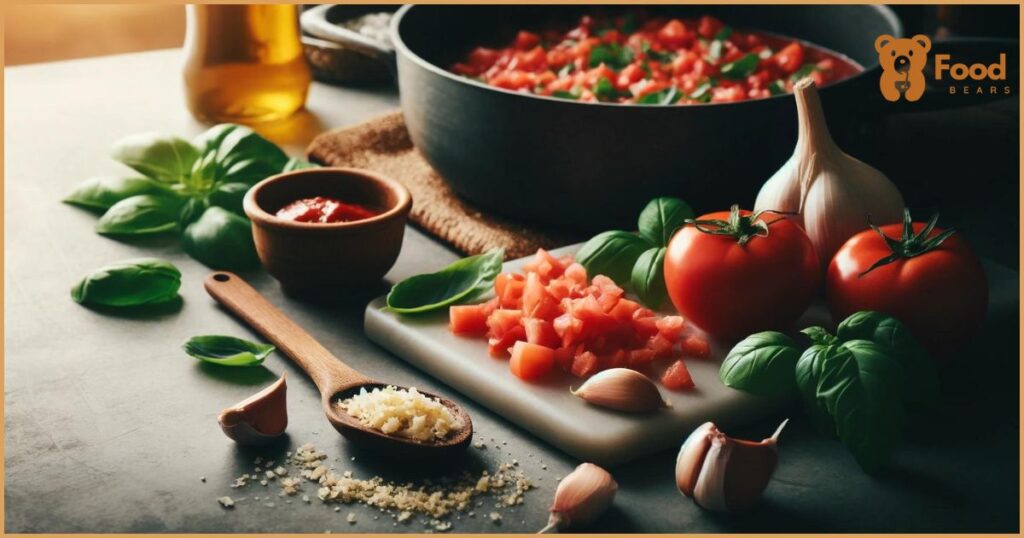
Creating your pizza sauce at home can elevate your pizza to a new level. Here are two popular methods: cooked and uncooked, each offering unique flavors and benefits.
Cooked Pizza Sauce Recipe for Beginners
Here, we provide a cooked and uncooked version to suit any taste or occasion.
Ingredients:
- 1 (28-ounce) can whole tomatoes
- 2 tablespoons olive oil
- 1/4 cup grated onions (or finely minced)
- 3 cloves garlic, pressed or minced
- 1/2 – 3/4 teaspoon dried oregano
- 1 teaspoon dried basil
- 1/4 – 1/2 teaspoon red pepper flakes (optional)
- 2 teaspoons sugar
- 1 teaspoon kosher salt
Instructions:
- Prepare the Tomatoes: Open the can of tomatoes. Using your hands, squeeze them into a bowl to break them into smaller pieces. Alternatively, you can use kitchen scissors to cut them up in the can or pulse them briefly with a blender.
- Cook the Aromatics: Heat 2 tablespoons of olive oil over medium heat in a medium saucepan. Add the grated or minced onions and cook for about 3-4 minutes, stirring often, until they become soft. Then, add the minced garlic and cook for another 30 seconds, being careful not to burn it.
- Simmer the Sauce: Add the crushed tomatoes to the saucepan. Stir in the oregano, basil, red pepper flakes (if using), sugar, and salt. Bring the mixture to a gentle simmer. Once it bubbles, reduce the heat to low and let it cook for about 30 minutes, stirring occasionally. This simmering process helps the flavors meld together and thickens the sauce.
- Taste and Adjust: After 30 minutes, taste the sauce. Add more salt, sugar, or spices to suit your preference.
- Use or Store: You can immediately use the sauce on your pizza. If you have leftovers, let the sauce cool completely. Store it in an airtight container in the refrigerator for up to one week, or freeze it for up to three months.
This cooked pizza sauce has a rich and deep flavor because simmering helps to concentrate the flavors of the tomatoes, onions, and herbs.
The sugar helps balance the acidity of the tomatoes, while the salt enhances all the flavors.
If you’re in a hurry, you can make a no-cook version by blending all the ingredients in a food processor for a fresher, more raw taste.
Uncooked Pizza Sauce Recipe for Beginners
Here is a simple no-cook pizza sauce recipe for beginners:
Ingredients:
- 1 (28-ounce) can whole peeled tomatoes, preferably San Marzano
- 2-3 cloves garlic, minced or pressed
- 1/2 teaspoon dried oregano
- 1/2 teaspoon dried basil
- 1/4 teaspoon red pepper flakes (optional)
- 1/2 teaspoon sugar
- 1/2 teaspoon salt
Instructions:
- Prepare the Tomatoes: Open the can of whole peeled tomatoes. Using your hands, gently squish the tomatoes in a bowl to break them into smaller pieces. Alternatively, you can use an immersion blender to pulse them briefly for a smoother texture. This step is crucial for achieving the perfect base for your pizza sauce.
- Combine Ingredients: In a mixing bowl, add the crushed tomatoes, minced garlic, dried oregano, dried basil, red pepper flakes (if using), sugar, and salt. Stir everything together until well mixed. This blend of pizza sauce ingredients ensures a rich and flavorful base.
- Let it Sit: Cover the bowl and let the sauce sit at room temperature for 30 minutes to 1 hour. Allowing the sauce to rest helps the flavors meld together, enhancing the overall taste. This waiting period is a critical step in recipe development for a no-cook sauce.
- Use or Store: You can use the sauce immediately on your pizza for a fresh, vibrant flavor. If you have leftovers, store the sauce in an airtight container in the refrigerator for up to one week or freeze it for up to three months. This convenient and efficient preparation method fits well into various cooking methods.
This no-cook pizza sauce is light, fresh, and simple to make with just a few ingredients. Combining tomatoes, garlic, and herbs creates a deliciously vibrant sauce without cooking.
You can use crushed tomatoes instead of whole ones for a thicker sauce. This easy recipe is perfect for beginners who want to make a quick and tasty pizza sauce.
Versatility of Pizza Sauce: Creative Uses Beyond Pizzas
With its robust blend of tomatoes, herbs, and spices, pizza sauce is a staple in Italian cuisine for pizzas and many dishes.
Its versatile pizza sauce applications demonstrate culinary versatility and offer various alternative uses in everyday cooking.
1. Sandwiches and Wraps
- Meatball Subs: Enhance meatball subs with a generous layer of pizza sauce, topped with mozzarella, for a quick Italian twist.
- Italian Wraps: Spread pizza sauce on wraps filled with Italian meats, cheese, and fresh veggies for a flavorful lunch.
2. Dips and Spreads
- Cheesy Pizza Dip: Combine pizza sauce with cream and shredded cheese, bake until perfectly melted, and serve as a hearty party dip.
- Spicy Marinara Dip: Boost the heat in pizza sauce with additional spices and use it for appetizers like mozzarella sticks or crispy calamari.
3. Pasta and Grains
- Pizza Pasta Bake: Toss pasta with pizza sauce, add your favorite pizza toppings, sprinkle with cheese, and bake for a comforting meal.
- Risotto: Infuse a tomato-rich flavor into risotto by integrating pizza sauce, a perfect base for adding proteins like chicken or veggies.
4. Proteins
- Chicken or Eggplant Parmesan: Use pizza sauce to simplify the preparation of these classic dishes, providing a rich tomato layer.
- Stuffed Peppers: Combine pizza sauce with rice and ground meat to fill bell peppers for a delicious and easy bake.
5. Breakfast Dishes
- Shakshuka: Use pizza sauce as a quick base for shakshuka, adding eggs and simmering until they are just set.
- Breakfast Pizzas: Create mini breakfast pizzas with English muffins, pizza sauce, scrambled eggs, and a sprinkle of cheese.
Comparison: Homemade vs. Store-Bought Pizza Sauce
Regarding pizza sauce, the debate between homemade and store-bought versions is not just about taste.
It’s also about health benefits, cost, and personal satisfaction. Let’s dive into how these two options stack up against each other.
1. Health Implications
Homemade pizza sauce typically contains fresher, less processed ingredients. You control what goes in, meaning no unnecessary preservatives, lower sodium, or added sugars.
This can be a significant health advantage, especially for those monitoring their intake for health reasons.
On the other hand, store-bought sauces often include preservatives and additives to extend shelf life and enhance flavor. These can sometimes be less optimal for those with dietary restrictions or health concerns.
2. Taste Comparison
The flavor of homemade sauce is often more affluent and can be customized to your liking.
You can adjust the amount of garlic, the type of tomatoes, and the mix of herbs to suit your palate. This customization ensures that the sauce perfectly complements the pizza toppings.
The store-bought sauce is convenient and consistent. However, it might lack the depth of flavor from slowly simmering your sauce with carefully chosen ingredients.
While it serves in a pinch, it might not satisfy those cravings for a “just right” homemade taste.
3. Cost-Effectiveness
Making your pizza sauce can be more cost-effective in the long run, especially if you buy ingredients in bulk or grow your herbs. The initial investment in quality ingredients can pay off over multiple batches.
Purchasing sauce from the store is initially cheaper and saves time, which can be a significant factor for busy individuals or those not inclined toward cooking.
4. Encouraging Personal Choice
Choosing between homemade and store-bought pizza sauce depends on your priorities: health, flavor, cost, or convenience.
Homemade sauce offers a rewarding experience with potentially healthier results, while store-bought sauce wins on convenience and consistency.
Explore both options and decide which best fits your lifestyle and pizza preferences. Each has its merits in the vibrant world of culinary choices influenced by the food industry. This exploration enhances your cooking skills and deepens your appreciation for the craft of creating delicious, wholesome food.
FAQs
How do you make homemade pizza sauce?
To make homemade pizza sauce, combine tomato sauce, garlic powder, red pepper flakes, and other seasonings according to your preference. Simmer the ingredients on low heat for 10-15 minutes until the sauce thickens.
What is the best pizza sauce to use?
The best pizza sauce uses high-quality ingredients like San Marzano tomatoes and incorporates flavorful seasonings to enhance the taste of the sauce.
What are the essential ingredients for a good pizza sauce?
The essential ingredients for a good pizza sauce include tomato sauce, garlic powder, red pepper flakes, and additional seasonings such as basil and oregano for added flavor.
What makes a great pizza sauce?
An excellent pizza sauce perfectly balances tomato flavor, seasoning, and thickness. It should enhance the overall taste of the pizza without overpowering the other ingredients.
Why is homemade pizza sauce better than store-bought?
Homemade pizza sauce allows you to control the quality and quantity of ingredients, ensuring a fresher taste and a sauce tailored to your preferences. Plus, it can be more cost-effective in the long run.
Conclusion: The Art of Perfect Pizza Sauce
Creating your pizza sauce with high-quality ingredients enhances your meals’ flavor and nutritional value.
Fresh tomatoes, aromatic herbs, and rich olive oil offer a superior taste and bring health benefits and a sense of personal accomplishment to your cooking endeavors.
Why not try crafting your sauce today? Experiment with both cooked and uncooked versions to discover your preferred flavor profile. Once you’ve mastered your recipe, share your culinary creations and experiences with others.
Engage with online communities, post on social media, or enjoy a discussion with family and friends about your homemade sauce. This not only enriches your culinary skills but also fosters community engagement.
Embrace the joy of making pizza sauce at home—it’s a simple step towards healthier, tastier eating. Enjoy the process and savor every bite!

Ella Foster, co-founder of FoodBears.com, is a skilled writer whose love for cooking fuels her creative work. Her passion for experimenting in the kitchen brings authentic flavor and culinary inspiration to every piece she crafts for the platform.
